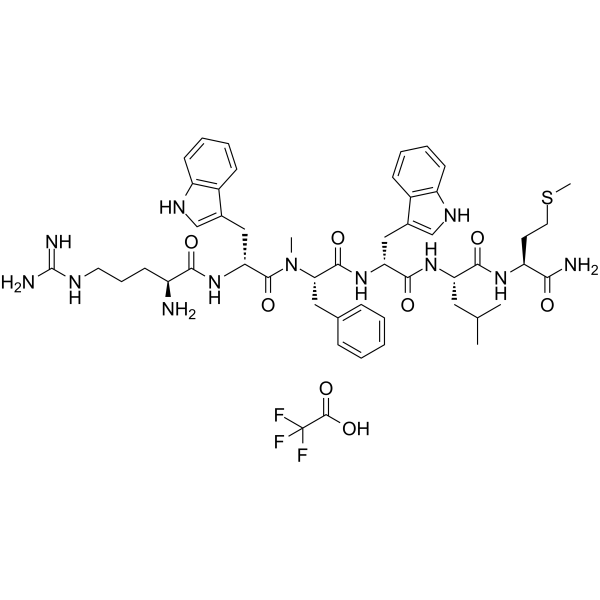上海金畔生物科技有限公司为生命科学和医药研发人员提供生物活性分子抑制剂、激动剂、特异性抑制剂、化合物库、重组蛋白,专注于信号通路和疾病研究领域。
Antagonist G TFA
Antagonist G TFA 是有效的后叶加压素 (vasopressin) 的拮抗剂。Antagonist G 也是弱的GRP 和缓激肽的弱拮抗剂。Antagonist G 可诱导 AG-1 的转录,是癌细胞对化疗增敏。
Antagonist G TFA Chemical Structure
| 规格 |
|
是否有货 |
|
| 100 mg |
|
询价 |
|
| 250 mg |
|
询价 |
|
| 500 mg |
|
询价 |
|
* Please select Quantity before adding items.
Antagonist G TFA 的其他形式现货产品:
Antagonist G
| 生物活性 |
Antagonist G TFA is a potent vasopressin antagonist. Antagonist G is also a weak antagonist of GRP and Bradykinin. Antagonist G induces AP-1 transcription and sensitizes cells to chemotherapy[1][2].
|
体外研究
(In Vitro) |
Antagonist G (0-100 μM) induces apoptosis is redox-sensitive and caspase-dependently in SCLC cells[2].
Antagonist G activates JNK1 in SCLC cells[2].
Antagonist G is not intrinsically a free radical oxygen donor but stimulates free radical generation specifically within SCLC cells (6.2-fold) and increases the activity of the redox-sensitive transcription factor AP-1 by 61%[2].
上海金畔生物科技有限公司 has not independently confirmed the accuracy of these methods. They are for reference only.
Cell Viability Assay[2]
| Cell Line: |
SCLC cell lines NCI-H69, NCI-H510 and CHO-K1 cells. |
| Concentration: |
0-100 μM. |
| Incubation Time: |
24 h. |
| Result: |
Inhibited cell growh. |
|
| 分子量 |
|
| Formula |
|
| Sequence Shortening |
|
| 运输条件 |
Room temperature in continental US; may vary elsewhere.
|
| 储存方式 |
Please store the product under the recommended conditions in the Certificate of Analysis.
|
| Solvent & Solubility |
In Vitro:
H2O
Peptide Solubility and Storage Guidelines:
1. Calculate the length of the peptide.
2. Calculate the overall charge of the entire peptide according to the following table:
| |
Contents |
Assign value |
| Acidic amino acid |
Asp (D), Glu (E), and the C-terminal -COOH. |
-1 |
| Basic amino acid |
Arg (R), Lys (K), His (H), and the N-terminal -NH2 |
+1 |
| Neutral amino acid |
Gly (G), Ala (A), Leu (L), Ile (I), Val (V), Cys (C), Met (M), Thr (T), Ser (S), Phe (F), Tyr (Y), Trp (W), Pro (P), Asn (N), Gln (Q) |
0 |
3. Recommended solution:
| Overall charge of peptide |
Details |
| Negative (<0) |
1. Try to dissolve the peptide in water first.
2. If water fails, add NH4OH (<50 μL).
3. If the peptide still does not dissolve, add DMSO (50-100 μL) to solubilize the peptide. |
| Positive (>0) |
1. Try to dissolve the peptide in water first.
2. If water fails, try dissolving the peptide in a 10%-30% acetic acid solution.
3. If the peptide still does not dissolve, try dissolving the peptide in a small amount of DMSO. |
| Zero (=0) |
1. Try to dissolve the peptide in organic solvent (acetonitrile, methanol, etc.) first.
2. For very hydrophobic peptides, try dissolving the peptide in a small amount of DMSO, and then dilute the solution with water to the desired concentration. |
|
| 参考文献 |
-
[1]. P J Woll, et al. A neuropeptide antagonist that inhibits the growth of small cell lung cancer in vitro. Cancer Res. 1990 Jul 1;50(13):3968-73.
[2]. A C MacKinnon, et al. [Arg6, D-Trp7,9, NmePhe8]-substance P (6–11) (antagonist G) inducesP-1 transcription and sensitizes cells to chemotherapy. Br J Cancer. 2000 Oct; 83(7): 941–948.
|
所有产品仅用作科学研究或药证申报,我们不为任何个人用途提供产品和服务

